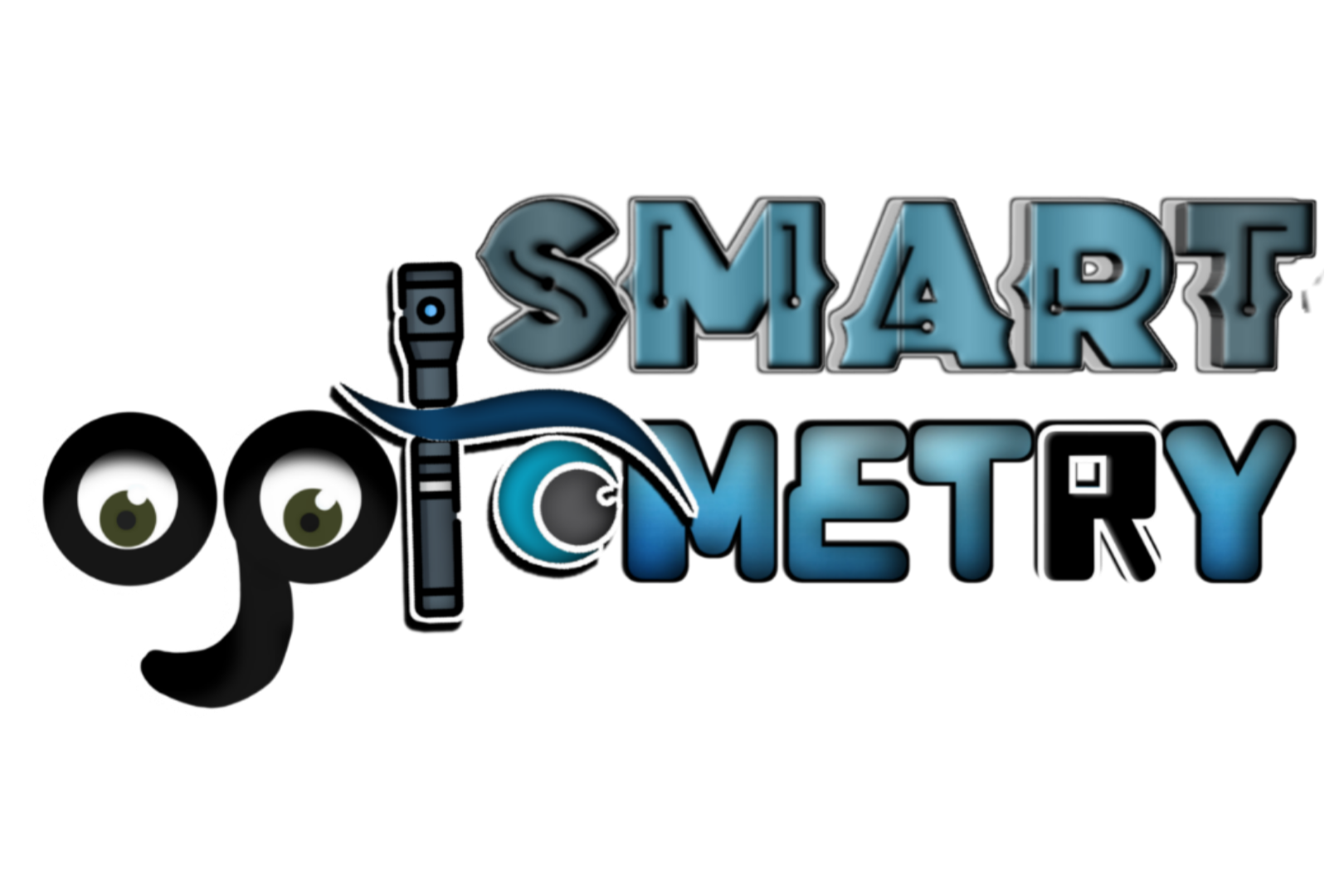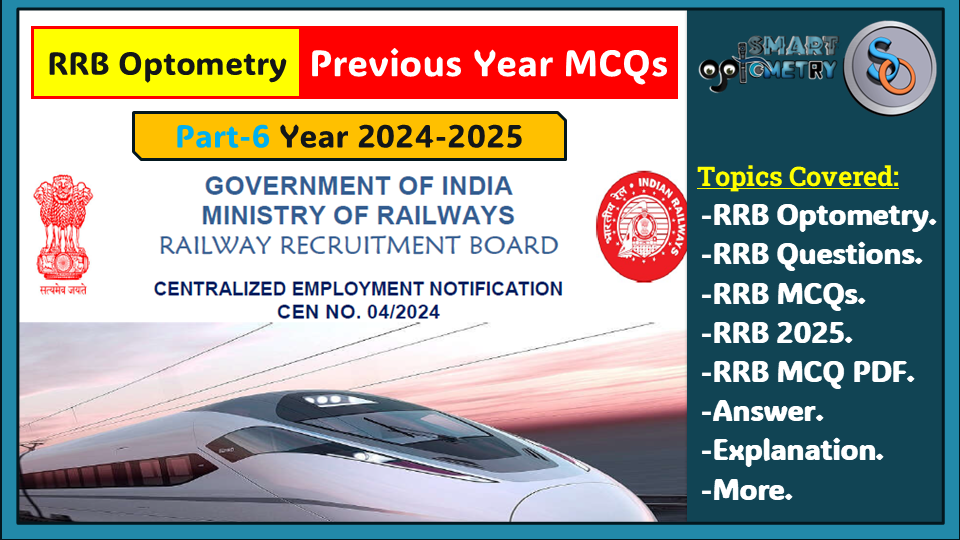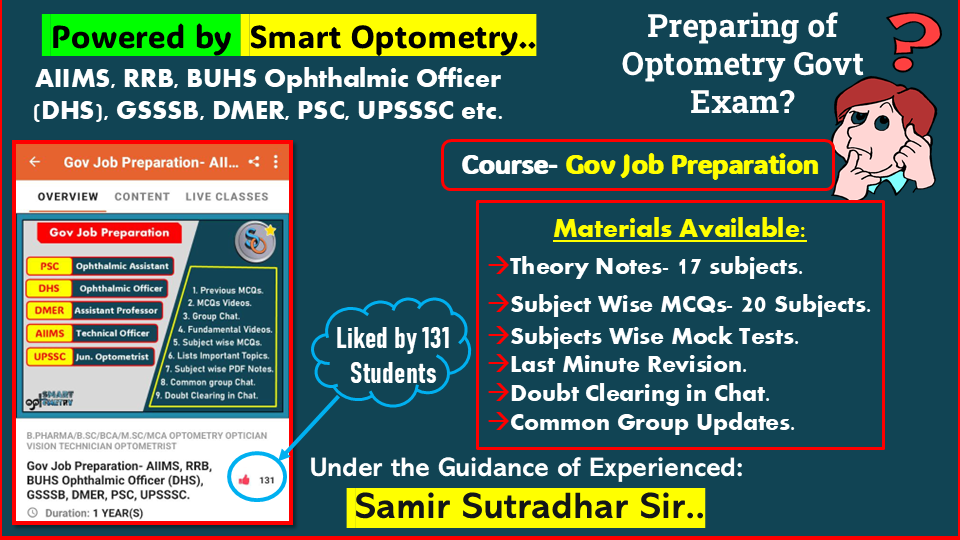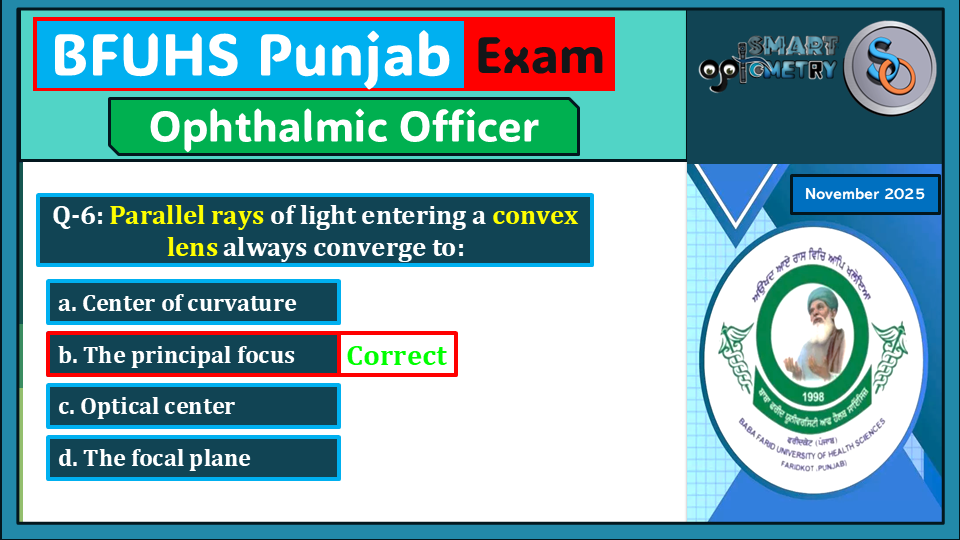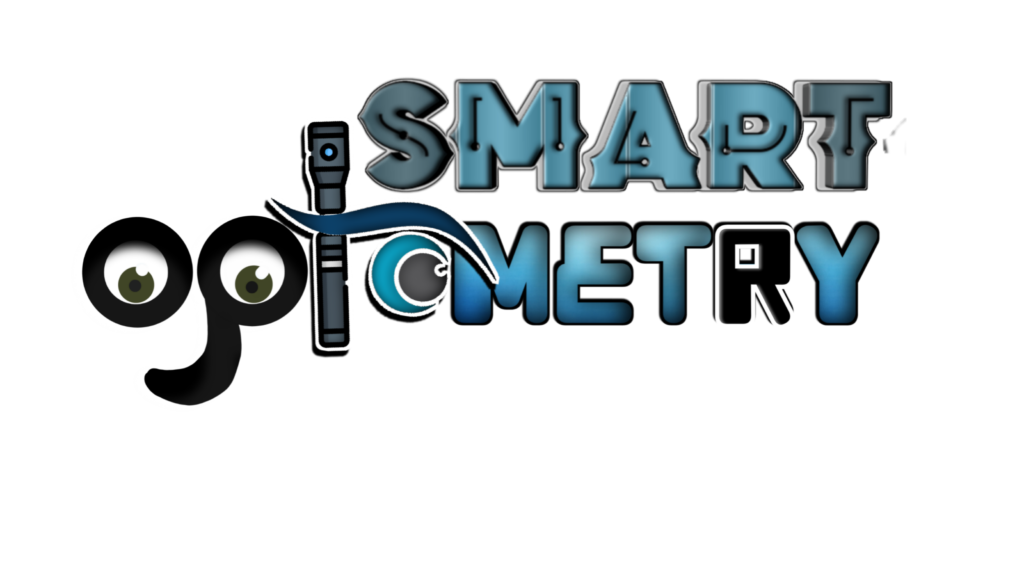Q.51 What does extraocular motility testing evaluate?
- Corneal thickness
- Retinal health
- Eye muscle function
- Lens clarity
Click “Show more” to see the answer and explanation.
Answer: 3. Eye muscle function
Explanation:
This test checks the six extraocular muscles (per eye) by having the patient follow a target through the cardinal gazes. Restrictions or nerve palsies produce characteristic patterns (e.g., CN III palsy limits elevation/adduction).
Note: Prepare for RRB Optometry Exam with our course “Optometry Gov Job Preparation”. This course provides: 150+ Subjects wise PDF Notes, 150+ Fundamental Optometry Videos, 5000+Subjectwise MCQs, 2000+ Previous Years MCQs, Mock Tests Group Chat, Doubts Clearing for 1 year.
.
.
Q.52 Which of the following statements correctly describes the clinical significance of the brachial plexus in relation to arm movement?
- The brachial plexus is responsible for the movement of the muscles in the upper limb, and its injury can result in paralysis of the arm muscles.
- The brachial plexus is located in the neck and does not affect the upper limb’s motor or sensory functions.
- The brachial plexus only contributes to sensation in the arm and does not play a role in motor control.
- The brachial plexus exclusively supplies the muscles of the forearm, leaving the hand unaffected in case of injury.
Click “Show more” to see the answer and explanation.
Answer: 1. The brachial plexus is responsible for the movement of the muscles in the upper limb, and its injury can result in paralysis of the arm muscles.
Explanation:
Formed from C5-T1 roots, the brachial plexus gives rise to all major arm nerves (median, ulnar, radial etc.). Injuries (e.g., Erb’s palsy from C5-C6 damage) cause motor/sensory deficits specific to the affected trunks/cords.
.
.
Q.53 Which procedure measures the eye’s focusing ability objectively?
- Visual acuity test
- Retinoscopy
- Tonometry
- Color vision testing
Click “Show more” to see the answer and explanation.
Answer: 2. Retinoscopy
Explanation:
Retinoscopy determines refractive error without patient input by analyzing light reflex movement. The examiner uses trial lenses to neutralize movement, providing an objective baseline before subjective refinement.
Note: Prepare for your RRB Optometry Exam under experience Samir Sutradhar sir. Enroll in our Course “Optometry Gov Job Preparation” that will give you: 150+ Subjects wise PDF Notes, 150+ Fundamental Optometry Videos, 5000+Subjectwise MCQs, 2000+ Previous Years MCQs, Mock Tests Group Chat, Doubts Clearing for 1 year.
.
.
Q.54 What is the primary goal of low vision services?
- To provide surgical interventions
- To maximize remaining vision
- To restore normal vision
- To prevent eye diseases
Click “Show more” to see the answer and explanation.
Answer: 2. To maximize remaining vision
Explanation:
Low vision rehabilitation focuses on enhancing functional vision through aids (magnifiers, telescopes), lighting adjustments, and training—not curing impairment. It improves quality of life despite irreversible vision loss.
.
.
Q.55 What is uniocular movement?
- Movement of one eye independently
- Movement of both eyes together
- Movement of the pupil
- Movement of the eyelids
Click “Show more” to see the answer and explanation.
Answer: 1. Movement of one eye independently
Explanation:
Uniocular movements (duction) describe individual eye motions: adduction (nasal), abduction (temporal), elevation, depression, intorsion, and extorsion. Binocular movements (versions) require coordinated action of both eyes.
Note: Enroll in our Course “Optometry Gov Job Preparation” to prepare for RRB Optometry Exam under Experienced Samir Sutradhar sir. This course will give you: 150+ Subjects wise PDF Notes, 150+ Fundamental Optometry Videos, 5000+Subjectwise MCQs, 2000+ Previous Years MCQs, Mock Tests Group Chat, Doubts Clearing for 1 year.
.
.
Q.56 Which of the following is the most effective preventive measure against occupational vision problems related to prolonged exposure to digital screens?
- Reducing ambient lighting in the workplace to decrease glare.
- Frequent use of artificial tears to prevent eye dryness.
- The 20-20-20 rule, which involves looking at something 20 feet away for 20 seconds every 20 minutes.
- Continuous use of blue light blocking glasses without any breaks.
Click “Show more” to see the answer and explanation.
Answer: 3. The 20-20-20 rule, which involves looking at something 20 feet away for 20 seconds every 20 minutes.
Explanation:
This rule combats digital eye strain by periodically relaxing accommodation and vergence systems. While blue light filters may help, evidence for their superiority over regular breaks is limited.
.
.
Q.57 Which of the following is true about convergence insufficiency?
- It is characterized by the inability of the eyes to move inward to focus on near objects.
- It is unrelated to binocular vision.
- It is characterized by the inability of the eyes to move outward.
- It is caused by excessive tear production.
Click “Show more” to see the answer and explanation.
Answer: 1. It is characterized by the inability of the eyes to move inward to focus on near objects.
Explanation:
Convergence insufficiency (NPC >10cm) specifically impairs medial rectus coordination for near tasks. Unlike divergence insufficiency (distance diplopia), it responds well to vision therapy targeting fusional convergence.
Note: Prepare for RRB Optometry Exam with our course “Optometry Gov Exam”. This course provides: 150+ Subjects wise PDF Notes, 150+ Fundamental Optometry Videos, 5000+Subjectwise MCQs, 2000+ Previous Years MCQs, Mock Tests Group Chat, Doubts Clearing for 1 year.
.
.
Q.58 Which of the following refractive errors is characterized by difficulty in seeing objects at a distance, and is typically corrected by a concave lens?
- Myopia
- Astigmatism
- Hyperopia
- Presbyopia
Click “Show more” to see the answer and explanation.
Answer: 1. Myopia
Explanation:
Myopic eyes have excessive refractive power (long axial length/steep cornea), causing distant images to focus in front of the retina. Concave lenses diverge light to shift focus backward onto the retina.
.
.
Q.59 Which of the following most accurately describes the role of lamina cribrosa deformation in the pathogenesis of glaucomatous optic neuropathy?
- It causes anterior displacement of the optic nerve head, reducing retinal blood supply due to posterior ciliary artery compromise.
- It facilitates increased uveoscleral outflow, reducing intraocular pressure but increasing translaminar pressure gradient.
- It primarily impedes aqueous humor outflow, raising intraocular pressure and causing mechanical compression of the iris.
- It leads to axoplasmic flow stasis at the level of the lamina cribrosa, resulting in retinal ganglion cell apoptosis through mechanical and vascular compromise.
Click “Show more” to see the answer and explanation.
Answer: 4. It leads to axoplasmic flow stasis at the level of the lamina cribrosa, resulting in retinal ganglion cell apoptosis through mechanical and vascular compromise.
Explanation:
Elevated IOP bows the lamina cribrosa posteriorly, compressing axons and microvasculature. This disrupts axonal transport and nutrient delivery, ultimately causing ganglion cell death and characteristic cupping.
Note: Prepare for your RRB Optometry Exam under experience Samir Sutradhar sir. Enroll in our Course “Optometry Gov Job Preparation” that will give you: 150+ Subjects wise PDF Notes, 150+ Fundamental Optometry Videos, 5000+Subjectwise MCQs, 2000+ Previous Years MCQs, Mock Tests Group Chat, Doubts Clearing for 1 year.
.
.
Q.60 The power of a lens is defined as:
- The ratio of the object distance to the image distance
- The thickness of the lens divided by its diameter
- The product of the focal length and the refractive index
- The reciprocal of the focal length in metres
Click “Show more” to see the answer and explanation.
Answer: 4. The reciprocal of the focal length in metres
Explanation:
Lens power (in diopters) = 1/focal length (m). A +2D lens converges light at 0.5m, while a -5D lens diverges light as if from a virtual focus 0.2m behind the lens.
.
.
Tags:
RRB Optometry Previous Year MCQs, RRB Optometry Exam MCQs, RRB Optometry MCQ Questions, RRB Optometry Mock Test, RRB Optometry Exam Practice Questions, RRB Optometry Previous Papers, RRB Optometry Sample Questions, RRB Optometry Exam Question Bank, RRB Optometry Solved MCQs, RRB Optometry Exam Model Papers, RRB Optometry Online Test Series, RRB Optometry Past Year Papers, RRB Optometry Important MCQs, RRB Optometry Exam Question Paper PDF, RRB Optometry Free MCQ Test, RRB Optometry Exam Practice Set, RRB Optometry Exam Multiple Choice Questions, RRB Optometry Last Year Questions, RRB Optometry CBT Exam Questions, RRB Optometry Subject-wise MCQs, RRB Optometry Exam Study Material, RRB Optometry MCQs with Answers, RRB Optometry Preparation Questions, RRB Optometry Exam Self-Assessment, RRB Optometry Exam Quiz, RRB Optometry Question Paper Download, RRB Optometry Exam Mock Questions, RRB Optometry Previous Exam Analysis, RRB Optometry Past Year Question Papers with Solutions, RRB Optometry Online Practice Test, RRB Optometry Exam Chapter-wise MCQs, RRB Optometry Exam Revision Questions, RRB Optometry Computer-Based Test MCQs, RRB Optometry Free Practice Papers, RRB Optometry Exam Question Format, RRB Optometry Exam Preparation Guide, RRB Optometry Objective Questions, RRB Optometry Competitive Exam Questions, RRB Optometry Important Questions, RRB Optometry Exam Test Series, RRB Optometry Sample MCQs, RRB Optometry Entrance Exam Questions, RRB Optometry Online Quiz, RRB Optometry Practice Exams, RRB Optometry Exam Latest MCQs, RRB Optometry Expected Questions, RRB Optometry Exam Study Notes with MCQs, RRB Optometry Exam Chapter-wise Test, RRB Optometry Exam 2025 MCQs, RRB Optometry Previous Year Question Paper Download, RRB optometry exam 2025 answer key, RRB optometry exam 2025 question paper, RRB optometry exam 2025 PDF download free, RRB Optometrists 2025 Question paper,
- Check Our Courses: Ophthalmic Instrumentation, Clinical Refraction, Contact Lens, Binocular Vision, Dispensing Optics, MCQs in Optometry
- Download our App “Optometry Notes & MCQs” from Google Play Store.
